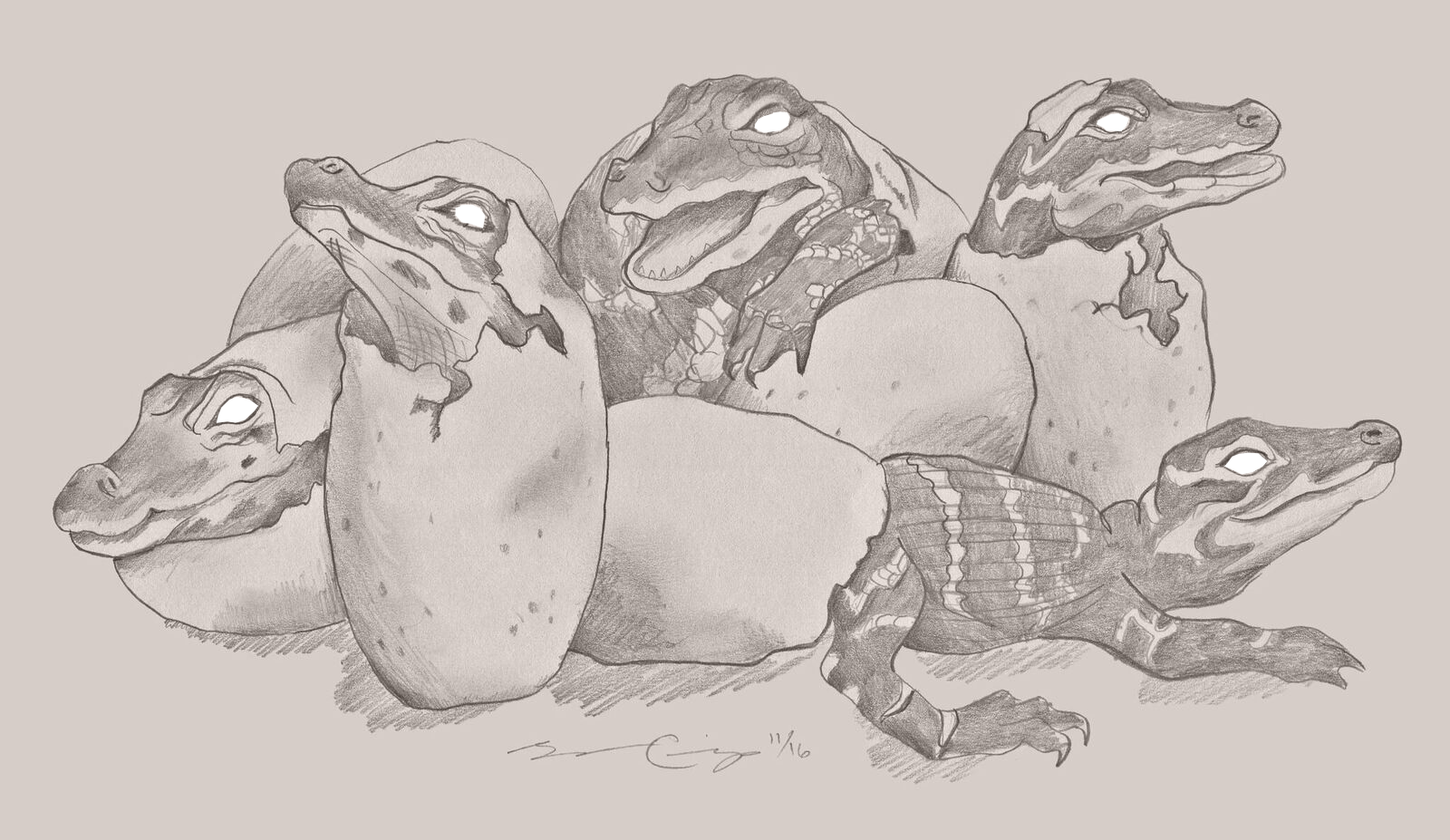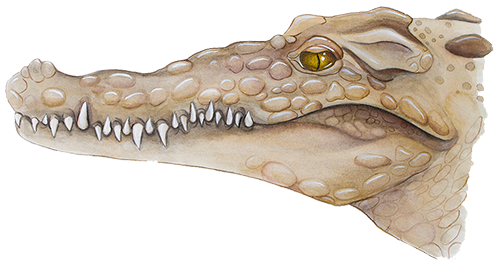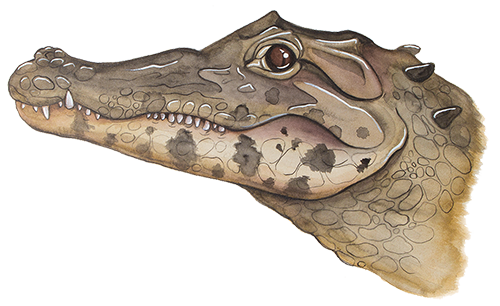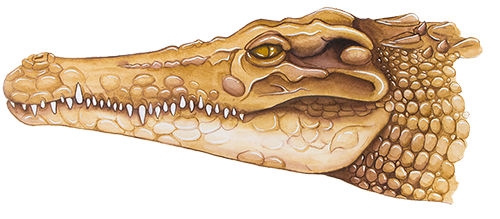Sources Sketches and illustrations by Shannon Cummings
- Professional reviewers: Melissa Bernhard from Mote (did past work on alligators) and her colleagues from other institutions, including Allan Woodward from FWC.
- American Crocodile: species profile. (2016, November 8). Retrieved from: https://www.nps.gov/ever/learn/nature/crocodile.htm
Info on: species range, differentiating from other crocodilians, appearance, feeding, behavior, survival issues, and more.
- Mazzotti, F. J., and Cherkiss, M. S. (2003). Status and Conservation of the America
n Crocodile in Florida: Recovering an Endangered Species While Restoring an Endangered Ecosystem. University of Florida, Ft. Lauderdale Research and Education Center Technical Report. Retrieved from: https://www.nps.gov/ever/learn/nature/upload/MON97-7FinalReportSecure.pdf
Info on: threats to survival and conservation actions for the American crocodile; crocodiles as a flagship species for protecting estuaries; crocodile conservation connected to water flow; types of habitats and geographic range that crocodiles inhabit; management of the species in Florida; human-crocodile interactions…
- Alligator Facts. (2016, November 8). Retrieved from: http://myfwc.com/wildlifehabitats/managed/alligator/facts/
Brief info on multiple alligator topics with Florida focus, such as diet, size, range, conservation status, reproduction and thermoregulation. Includes interesting section/link with adaptations info.
- Differences Between Crocodiles and Alligators. (2016, November 8). Retrieved from: http://myfwc.com/wildlifehabitats/managed/american-crocodile/croc-or-gator/
Succinct table with key differences, including illustrative photos. Since this is a government agency website, FWC, we could presumably ask for pictures posted there or here for possible use in our exhibit.
- Squires, M. A. Farris, S. C., Jeffrey, B. M., and Mazzotti, F. J. (2013). Native and Non-native Crocodilians of Florida. WEC335, one of a series of the Wildlife Ecology and Conservation Department, UF/IFAS Extension. Retrieved from: http://edis.ifas.ufl.edu/uw380
Differences among four species in Florida, the native American alligator and American Crocodile, along with the non-native spectacled caiman and Nile crocodile.
- American Alligator: Alligator mississippiensis. (2008). Retrieved from: https://www.fws.gov/endangered/esa-library/pdf/alligator.pdf
Details about alligator population decline and recovery; description and diet; breeding and life history; biological role.
- Classification of Living Crocodilians. (2016, November 8). Retrieved from: http://www.iucncsg.org/pages/Classification-of-Living-Crocodilians.html
Lists 24 species in three families within class Crocodilia.
- Ross, J. P., and Wermuth, H. F. (2016, November 8). Crocodile. Encyclopaedia Britannica. Retrieved from: https://www.britannica.com/animal/crocodile
Mentions 23 Crocodilian species (different from above). General characteristics of crocodilians; distribution (broadly, not just Florida); natural history; behavior; clip of alligator vocalization (bellowing); anatomy & physiology; breeding; adaptations; evolution and classification. I haven’t read it all, but I assume most of it is broad and focused on Crocodilians as a class, rather than any single species in depth. Not sure.
- Non-natives - Spectacled Caiman. (2016, November 9). Retrieved from: http://myfwc.com/wildlifehabitats/nonnatives/reptiles/spectacled-caiman/
Very basic info on where it’s from, how it has invaded Florida, what it looks like and why it’s a concern.
- Common Caiman. (2016, November 9). Retrieved from: https://nas.er.usgs.gov/queries/factsheet.aspx?SpeciesID=222
More detailed and more recent information about where common caimans (same sci name as spectacled caimans) have invaded, as late as 2007-2009 in Florida. Invaded areas and impacts beyond Florida. Impacts of invasions.
- Spectacled Caiman. (2016, November 9). Retrieved from:
http://www.arkive.org/spectacled-caiman/caiman-crocodilus/
Biology/behavior, life history, feeding, appearance/size, habitat, conservation status, hunting and pet trade.
- More resources on various crocodilians - IUCN Crocodile Specialist Group: http://www.iucncsg.org/ ; http://www.iucncsg.org/pages/Species-Accounts.html
- Adaptations. (2016, November 8). Retrieved from http://bioweb.uwlax.edu/bio203/s2007/schreibe_bran/adaptations.htm
Information on the adaptations on crocodilians.
Biology/behavior, life history, feeding, appearance/size, habitat, conservation status, adaptations
Biology/behavior, life history, feeding, appearance/size, habitat, conservation status,
adaptations
Biology/behavior, life history, feeding, appearance/size, habitat, conservation status,
adaptations
Information specifically pertaining to crocodilians nictitating membrane.
Information specifically pertaining to the lacrimal glands and the nictitating membrane
Crocodiles facts and pictures. Facts about biology.
All about crocodilians adaptations.
Information specifically about the bite force of crocodiles
Information about alligators tendency to undergo torpor during the winter months.
Information regarding the bite force strength between crocodiles and alligators.
- Rice, A. N. (2004). Diet and condition of American alligators (Alligator mississippiensis) in three central Florida lakes: A thesis presented to the graduate school of the University of Florida. Retrieved from: http://myfwc.com/media/310266/Alligator-Rice-A.pdf
Discusses how American alligators are opportunistic predators, whose diet may vary depending on the location and the condition of the habitat. Specifically focuses on gators in Lake Apopka, Lake Griffin and Lake Woodruff in central Florida. Discusses prey types and body condition, but acknowledges that prey may not be the only factor in body condition and/or population success.
- Alligators and Crocodiles. (2016, November 10). Retrieved from: http://edis.ifas.ufl.edu/topic_alligators
Links on the University of Florida website to multiple resources that might help. Includes links about human-alligator relationship and conflict, along with alligators as indicator species for Everglades restoration.
- Swiman, E., Hostetler, M., Main, M., Miller, S. W. (2005). Living with Alligators: A Florida Reality. WEC203, one of a series of the Wildlife Ecology and Conservation, UF/IFAS Extension. Retrieved from: http://edis.ifas.ufl.edu/uw230
Includes “How can I stay safe around alligators?” Gives FWC number to report nuisance gators. Also, common misconceptions about alligators.
- Ober, H.K., Dutton, H.J., Woodward, A.R., Hord, L.J. and Giuliano, W.M. Giuliano. (2014). Managing Conflicts with Wildlife: Living with Alligators. WEC348, one of a series of the Wildlife Ecology and Conservation Department, UF/IFAS Extension. Retrieved from: http://edis.ifas.ufl.edu/uw393
Lists specific concerns/risks around alligator interactions and how to decrease risk.
- Martin, S. (2008). Global diversity of crocodiles (Crocodilia, Reptilia) in freshwater. Hydrobiologia, 595:1. Retrieved from: http://rd.springer.com/article/10.1007/s10750-007-9030-4
Notes that, despite some crocodilian species like the spectacled caiman and Nile Crocodile having broader distributions, most crocodilian species have restricted ranges, and that has been one factor leading to their endangered status in many cases. “Half of the existing crocodilian species are considered either as being endangered or threatened according to the Red List criteria of the World Conservation Union IUCN.”
- Livingston S. (2016) Man-eating monster crocodile may be Florida’s newest invasive species. University of Florida News. Retrieved from: http://news.ufl.edu/articles/2016/05/man-eating-monster-crocodile-may-be-floridas-newest-invasive-species.php
UF news story based upon a journal article describes UF’s finding of a few non-native Nile crocodiles in south Florida in recent years.
- Florida Fish and Wildlife Conservation Commission Alligator Bites on People in Florida (September 2016). Retrieved from: http://myfwc.com/media/310203/Alligator-GatorBites.pdf
Lists numbers and information about unprovoked gator bites in Florida up to September 2016. Provides number for the Statewide
Nuisance Alligator Program: 1-866-FWC-GATOR (392-4286).
- McNabb, B.K.(2002). The Physiological Ecology of Vertebrates: A View From Energetics.Ithaca, NY : Cornell University Press
A lot of good information about the biological processes that occur within vertebrates including crocodilians.
- Huchzermeyer, F.W. (2003). Crocodiles: Biology, Husbandry and Diseases.Cambridge, MA:Cabi publishing
General information about the biology and caretaking practices for maintaining
Crocodile habitats
General information about Crocodile behavior and history
- Two links on reporting non-native species in Florida - one FWC page recommending I’ve Got 1 and one link to I’ve Got 1 website: http://myfwc.com/wildlifehabitats/nonnatives/reporting-hotline/
http://www.ivegot1.org/
- Houston, T. The American alligator and its importance to the Florida Everglades. (2012). Retrieved from: http://www.esa.org/esablog/ecology-in-policy/the-american-alligator-and-its-importance-to-the-florida-everglades/
- Suckling, K., Greenwald, N., Curry, T. (2012) On Time, On Target: How the Endangered Species Act is Saving America’s wildlife. Retrieved from: http://www.esasuccess.org/pdfs/110_REPORT.pdf
Table 2 says that American crocodiles had a population increase of 1,290% between 1975 and 2007. This report does not mention American Alligators.
- American Alligator. (2016 November 11). Retrieved from: http://www.fishwildlife.org/files/Alligatorwebsite.pdf
Focuses on the decline and successful recovery of its populations, specifically in the context of trade in crocodilian products and CITES.
- The Endangered Species Act: A Wild Success. (2016 November 18). Retrieved from: http://www.biologicaldiversity.org/campaigns/esa_wild_success/
Has a paragraph on decline and recovery of American crocodile.
- American crocodile (Crocodylus acutus). (2016 November 18). Retrieved from: http://ecos.fws.gov/ecp0/profile/speciesProfile?spcode=C02J#crithab
Describes the U.S. federal Endangered Species Act listing of American crocodiles as threatened in Florida (the distinct population segment in Florida) and endangered elsewhere in their range. Specifies states/territories where it is known or believed to occur, along with Florida counties. Shows critical habitat in Florida. Additional background available from reclassification document filed in 2005: https://www.gpo.gov/fdsys/pkg/FR-2005-03-24/pdf/05-5640.pdf#page=1
- Caiman crocodilus (Common caiman). (2016 November 18). Retrieved from: http://www.iucnredlist.org/details/46584/0
Lists the species as lower risk/least concern and widespread (notes U.S. introduction), but says it is locally extirpated in some places. Looks like status has improved, since it had an IUCN listing of threatened in the late 1980s. The current listing is from 1996 and needs updating.
- Crocodylus niloticus (Nile crocodile). 2016 November 18). Retrieved from: http://www.iucnredlist.org/details/46590/0
Was “vulnerable” from early ‘80s through 1990, but lower risk/least concern as of 1996. Needs updating also
- Alligator mississippiensis. 2016 December 8. Retrieved from: http://www.flmnh.ufl.edu/florida-vertebrate-fossils/species/alligator-mississippiensis
Discusses fossil record of Alligator species in Florida. Includes mention of fossils 2 million years old.








